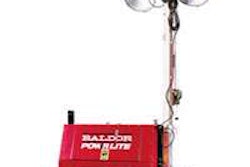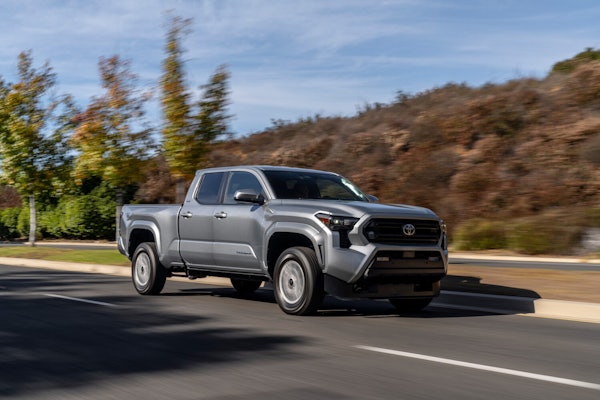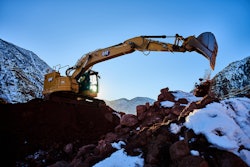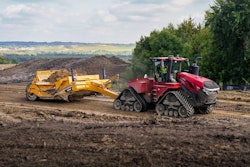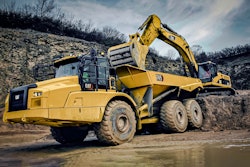Installing an SRW properly will avoid a range of problems and costly corrections. Here’s how to do it.
by Gabriela Mariscal, Geotechnical Engineer, National Concrete Masonry Association
Modular block walls, or segmental retaining walls (SRWs) are a type of mechanically stabilized earth (MSE) structure built with mortarless concrete block facing commonly reinforced with geosynthetics.
Because they use no mortar and are conveniently sized, modular block walls can be assembled quickly and without heavy construction equipment. SRW blocks are “dry stacked”, relying on their weight and frictional, mechanical or shear interlock, along with the reinforcement and soil, to engineer durable MSE walls that offer facings available in a range of patterns, textures, colors, and finishes.
The variety of colors and textures available for SRW blocks allows designers to envision walls that integrate aesthetically with their surroundings, such as this colorful retaining wall in El Paso, Texas.Due to their modular nature MSEs can tolerate much larger settlements than reinforced concrete walls1, without showing signs of distress. Additionally, they can be reused or recycled. They do not contain the chemicals used to preserve wood or need the extensive form work and specialized labor required for cast in place retaining walls. The constant research of the block manufacturers is allowing them to produce higher quality products able to perform in different conditions.
Reduced labor time and cost, durability, and low maintenance requirements have made modular block walls a competitive design option for landscaping, commercial property development, and, of course, highway construction projects.
SRWs are a cost effective solution for stabilizing slopes near roads. Multiple SRWs are used to protect this road in Wisconsin from hillside erosion.According to the Federal Highway Administration (FHWA)2, the first MSE walls used in highway projects appeared in the early 1970s and the first modular block wall was used in the 1980s.
Today, there are more than 60,000 MSE walls in excess of 35 feet high along U.S. highways. Another 9 million-square-feet of MSE walls are being constructed annually using different materials. The tallest MSE wall, built along a runway at the Seattle-Tacoma International Airport, towers 140 feet high.
For the aforementioned reasons, MSE walls are used increasingly as support structures for ramps, bridge abutments, road elevations, bridges, grade changes, waterfront protection and it is important to know the mechanics of their analysis.
Analyzing MSE Wall Stability
A core feature of MSE wall design software is stability analysis, which is key to preventing MSE wall failure.
Attractive, low-maintenance bridges using SRWs are effective spans over challenging terrains. This two-lane bridge spans a creek in Beaverton, Ore.A recent article in the Journal of Geotechnical and Geoenvironmental Engineering documents such a MSE wall failure in Korea.3 An investigation revealed that “the inappropriate design and the low-quality backfill were mainly responsible for the wall failure, although the primary triggering factor was the rainfall infiltration.”
To minimize the possibility of MSE wall failure, designers should have a basic understanding of four important stability analyses: external stability, internal stability, compound and global stability.
External stability examines the reinforced soil zone and the facing column to determine the appropriate geosynthetic length to overcome base sliding, overturning about the toe, and foundation-bearing capacity.
Internal stability analyzes for geosynthetic reinforced soil walls determines the appropriate strength and distribution of the geosynthetic layers to ensure that the structural integrity of the reinforced zone is preserved with respect to reinforcement over-stressing, pullout of geosynthetic reinforcement layers from the anchorage zone, connection capacity at the face and internal sliding along the reinforcement layers.
Compound stability analyzes the coherence of the block-geosynthetic-soil system through potential compound slip circles that originate behind the soil-reinforced SRW. A special case of this analysis is the internal compound stability where the surfaces exit at the face of the wall.
Global stability analyzes the overall stability of the MSE wall and surrounding slopes and structures.
The internal compound stability method, has been introduced in the third edition of NCMA’s Design Manual for Segmental Retaining Walls and its SRWall 4.0 software, is a special case of the global stability analysis and does not replace it. The analysis considers the three parts in the system: the un-reinforced soil forces analyzed through slope stability methods; the reinforcement with resisting forces; and the facing contributing with resisting shear or connection forces.
The "flexibilty" of SRW blocks allow for graceful walls with curves and changing heights.Compound and global stability failure surfaces will not generally be critical for simple structures with rectangular geometry, relatively uniform reinforcement spacing, average soils and a near vertical face. But if complex conditions exist (high surcharge loads, significant slopes at the toe or above the wall, weak layers of soil or tiered structures) compound and global failures may be a design limit state.
Design software accelerates use of MSE walls
To speed up the design process different software packages are available that uses all the different design methods. The National Concrete Masonry Association (NCMA) has played an instrumental role in developing methodology and software for Modular Block Wall (SRW) design and analysis. NCMA’s first software version was released in the mid 1990s. The latest version, SRWall 4.0, was released last summer and includes the new Internal Compound Stability.
Another software program used by many state highway and federal agencies is MSEW(3.0), first developed for the FHWA in the late 1990s by ADAMA Engineering. It offers several “design methods.” The NCMA 1997 design method is also included.
Technical Resources Available
To assist engineers in the design and analysis of modular block MSE walls, NCMA, a nonprofit industry association, does constatnt research tp improve and refine production, methodology and installation practices. NCMA has released a new 3rd edition of its Design Manual for Segmental Retaining Walls and offers other technical documents. A SRW design course is also available. Information on these resources and the free 30-day trial version of SRWall 4.0 software, is available at www.ncma.org.
As segmental/modular block retaining wall technology advances and highway construction and maintenance budgets face further strain, expect to see additional growth in the use of MSE walls for a variety of applications.
References:
1- Mechanically Stabilized Earth Walls and Reinforced Soil Slopes Design & Construction Guidelines, Publication No. FHWA-NHI-00-043, March 2001
2 – Transportation Report News, “Mechanically Stabilized Earth Walls on the Interstate Highway System – Thirty Years of Experience, Daniel Alzamora and Richard J . Barrows, US Department of Transportation, March-April 2007
3 – Journal of Geotechnical and Geoenvironmental Engineering, Vol. 132, No. 12, December 2006
This article and photos courtesy of National Concrete Masonry Association.





